|
Virtually all
cultures throughout time have developed fighting systems for the purpose of self-protection. The people of the
Far East seem to be unique in the degree to which they have systematized these arts and the formality with which they have
passed them on from generation to generation. In China, various fighting systems developed through the combination of
native and foreign techniques. Many of these styles were based on the movements
of animals. Three of these, those of the Tiger, Dragon, and Crane form the basis
of modern Uechi-ryu Karate-do.
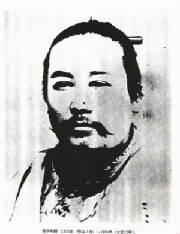
|
| Chou Tzu-ho |
Uechi-ryu actually traces its origins to a Chinese teacher by the
name of Chou Tzu-ho (spelled Zhou Zi He in Pinyin, pronounced Shu Shi-wa in Japanese). Master Chou (1874-1926),
who was born into a wealthy family in the town of Nanyu just south of Fuchou City (spelled Fuzhou in Pinyin, sometimes
spelled Foochow in English), was known to have studied under two well-known martial artists of the day. One,
Chou Pei (Zhou Bei in Pinyin) was a practitioner of Southern Shaolin Fist. Chou Tzu-ho's other teacher was
named K'o Hsi-ti (Ke Xi Di or He Xi Di in Pinyin) but we do not know the particular style which he taught.
With time, Chou Tzu-ho came to be proficient in a number of martial arts, especially Hu Hsing Ch'uan (Hu Xing
Chuan in Pinyin) which is known in English as Tiger Form Boxing.
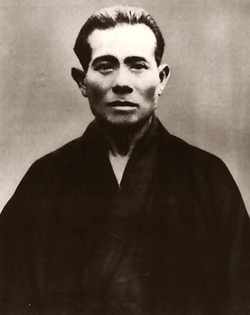
|
| Uechi Kambun at age 58 (approximately 1935) |
In 1877 the “founder” of Uechi-ryu, Uechi Kambun (alternately
Kanbun), was born on Okinawa. In 1896, at the age of 18, he went to Fuchou City which was located in Fukien (Fujian
in Pinyin) Province in southern China. There, he briefly studied a style called Kojo-ryu. Then, in 1897,
Mr. Uechi began studying under Chou Tzu-ho. In 1904 Master Uechi received his certificate of proficiency from Master
Chou. He then continued studying, furthering his knowledge. In 1906 Uechi Kambun opened his own school in Nanching (Nanjing
in Pinyin, pronounced Nansei in Japanese), Fukien Province. Master Uechi referred to the art which he taught as
Pan-gai-nun which means 1/2 hard, 1/2 soft. Uechi Kambun taught in Nanching until 1909 when he returned to Okinawa after a
total of about 13 years in China.
Once back on Okinawa, Uechi Kambun married and started farming. Despite
much pressure to resume teaching, he did not do so during this period of his life on Okinawa. He is said, however, to have trained on his own, and perhaps with a few friends. In 1924, after approximately 14 years back on Okinawa, Master Uechi moved to Wakayama, Japan
in an effort to make a better living for his family.

|
| Uechi Kambun at age 49 (approximately 1926) |
There,
Uechi Kambun resumed teaching in 1926. He did so at the urging of community leaders
who were involved in combating gang activity which plagued the Okinawan residents of Wakayama. Okinawans were looked
down upon by the mainland Japanese of the day and city officials were not particularly concerned with addressing the problem.
Therefore, the leaders of the Okinawan community had to resort to forming their own "neighborhood watch" groups and they
wanted the members of these groups and other law-abiding Okinawans to be trained in the martial arts. Uechi Kambun's
first student was Tomoyose Ryuyu, whom he taught on a private basis along with a few other acquaintances.

|
| Uechi Kambun at age 59 (1936) |
Master Uechi came to have more and more students and in 1932 the Pan-gai-nun-ryu
Karate-jutsu Institute was formed in Wakayama. In 1940 Master Uechi’s students changed the name of the school to the
Uechi-ryu Karate-jutsu Institute. To the best of our knowledge, Uechi Kambun continued to teach the art as he had learned
it from Chou Tzu-ho. He is not thought to have modified the art any more than does any other teacher whose understanding
of an art develops over the years. Thus, the name change was not motivated by Uechi Kambun actually creating a new style.
The change was a simple recognization of the fact that the Okinawan community in Wakayama thought of the art as "Uechi's style
of karate," thus "Uechi-ryu Karate."
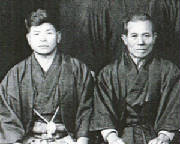
|
| Uechi Kambun (right) at age 60 with his senior student Tomoyose Ryuyu at age 40 (1937) |
Uechi Kambun gave instruction in Wakayama until he returned to Okinawa in 1946, after the end of World War II.
He had been away from his homeland for about 22 years. He left the Wakayama dojo in the hands of his senior student, Tomoyose
Ryuyu, who continued teaching there until his death in 1970.
Master Uechi did not offer instruction on a formal basis after
returning to Okinawa. However, he did teach a few students at his home on Ie-Jima,
a small island just off the northwest coast of Okinawa. There, in 1948, Uechi
Kambun died at the age of 71.
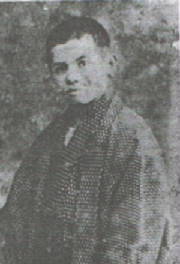
|
| Uechi Kanei at age 18 (approximately 1929) |
Upon the death of Uechi Kambun, his eldest son, Uechi Kanei (1911-1991), became the second master of the Uechi-ryu.
When Uechi Kambun originally moved to Wakayama in 1924 he had done so on his own. The rest of the family remained behind
on Okinawa. Then, in 1927, Uechi Kanei moved from Okinawa to mainland Japan and joined his father in Wakayama.
There he started studying Pan-gai-nun-ryu when he was approximately 16 years of age.

|
| Uechi Kanei with students in Amagasaki at age 30 (approximately 1941) |
After 10 years of training under his father, Uechi Kanei received his certficate of proficiency in Pan-gai-nun-ryu in
1937. Then, with his father's approval, he moved to Osaka where he opened a branch dojo. Unfortunately, the Osaka
dojo was not as successful as hoped and in 1940 Uechi Kanei moved to Amagasaki in Hyogo Prefecture, north of Osaka.
Although this dojo was more successful than his first, Uechi Kanei only taught in Amagasaki for about two years.
Then, in 1942, he (along with his wife and children) returned to Okinawa to care for his mother and younger siblings.
Once back on Okinawa, he taught a small group of students (including his younger
brother and other neighborhood youths) at the new family home in Nago. This training was interrupted by the closing
days of World War II and the Battle of Okinawa. Indeed, Uechi Kanei was called into military service in the Japanese
army in 1944.
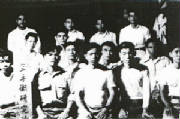
|
| Uechi Kanei at age 42 (1953) |
After the war was over in 1945 the post-war devastation and turmoil prevented formal
karate training from being a priority. Several years passed, however, and after his father’s death in 1948, Uechi
Kanei moved to the Futenma area in 1949 and again began teaching Uechi-ryu, this time to the public at large.
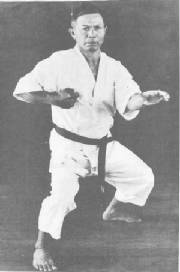
|
| Uechi Kanei at approximately age 54 (circa 1965) |
It was under Uechi Kanei’s leadership that the Uechi-ryu was modernized and
spread throughout the world. The core of the style remained the original Chinese art taught by Chou Tzu-ho and Uechi Kambun
but Uechi Kanei added five bridging kata and several two-person drills to the curriculum. He did so, not to create a
new style, but rather to maintain the interest of a new generation of students who were less inclined to endure the traditional
training methods.
Today, in addition to dojo on Okinawa and in Japan proper, there are thought to
be schools in Argentina, Australia, Brazil, Canada, Chile, Croatia, England, Estonia, Finland, France, Germany, Greece, Holland,
India, Israel, Italy, Mexico, New Zeeland, the Philippines, Poland, Saudi Arabia, Serbia, Slovenia, Sri Lanka, South Africa,
Switzerland, and the United States, as well as in other countries.

|
| Uechi Kanei in his later years |
In the final years of his life Uechi Kanei was in failing health and his eldest son, Uechi Kammei (also
transliterated as Kanmei), took over the Futenma dojo. Concurrently, the
Uechi-ryu on Okinawa broke into several separate organizations. Most of the
senior instructors on Okinawa formed the Okinawa Karate-do Kyokai, (commonly referred to by its Japanese abbreviation "Oki
Ku Kai"). The presidency of the Oki Ku Kai was rotated amongst the most senior
of these practitioners. Another major group was the Uechi-ryu Karate-do Kyokai
(commonly called the "Soke," or “head family") which was headed by Uechi Kammei until his death in 2015. During this period, a number of smaller organizations also formed on Okinawa. These included
the Uechi-ryu Karate-do Kenyukai, the Uechi-ryu Karate-do Shinkokai, the Pan-gai-nun-ryu (Hankonan-ryu) Karate-do Kyokai,
and the Okinawa Konan-ryu Karate-do Kyokai to name a few. In addition to these
various associations, there were also several independent dojo on Okinawa teaching the Uechi style of karate. The splintering
of Uechi-ryu continued through the years and, as of late 2009, the Oki Ku Kai itself had split into two groups (the Uechi-ryu
Oki Ku Kai and the Shohei-ryu Oki Ku Kai). Despite all the political divisions, despite the different organizational
names, and despite the minor differences between each instructor's method of teaching, all the practitioners in
these various groups continue to practice, what is in essence, the Uechi style of karate.
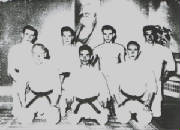
|
| George Mattson (front row right) with his teacher, Tomoyose Ryuko (front row center) in 1957 |
Approximately 1958 George Mattson began teaching the Uechi-ryu in the Boston area. Although other Americans had studied the style previously and had introduced it to the United States informally,
Mr. Mattson was the first to truly popularize the art in this country. He had
studied Uechi-ryu while in the service and was one of the first two Americans to receive dan rank in the style. With more than sixty dojo, New England is now one of the major centers of Uechi-ryu in the United States.
Mr. Mattson himself now resides in Florida.

|
| Allen Horton (far right); William Keith (2nd from left) in the mid 1960's |
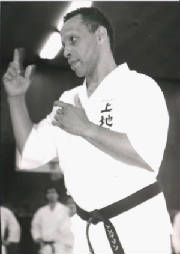
|
| James Thompson |
Allen Horton introduced Uechi-ryu to Kalamazoo about 1961. Like George
Mattson before him, Mr. Horton had studied Uechi-ryu under Tomoyose Ryuko on Okinawa while in the service. During the late 1960’s and the 1970’s Uechi-ryu was popularized in southwestern Michigan by
Mr. Horton’s senior student, William Keith. When Mr. Keith moved to Florida in the early 1980's he arranged
to have the Kalamazoo dojo taken over by James Thompson. Mr. Thompson was, and is, one of the senior American practitioners
of Uechi-ryu, having studied directly under Master Uechi Kanei for eight to nine years while in the service on Okinawa.
Mr. Thompson’s Okinawan Karate Academy in Kalamazoo is now the main dojo in Michigan.
There are also centers of Uechi-ryu
in New York State, Florida, Missouri, Arizona, California, and numerous other locations.
|

